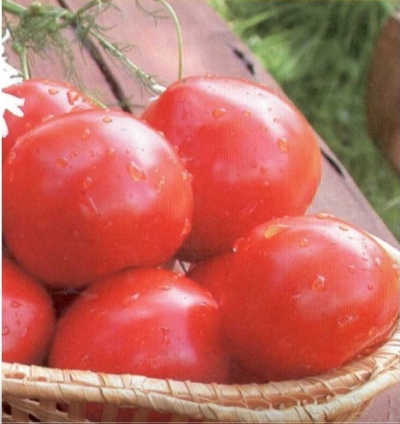
- Authors: FGBNU "Federal Scientific Center of Vegetable Growing"
- Year of approval: 1984
- Category: grade
- Growth type: determinant
- Appointment: universal
- Ripening period: early
- Ripening time, days: 92-102
- Growing conditions: for open ground
- Bush size: undersized
- Bush height, cm: 35-45
Lovers of small tomatoes suitable for whole-fruit canning will be pleased with the Otradny variety. An unpretentious determinant plant has a strong immunity, an almost complete inability to form stepchildren, a piquant taste and versatility in use. The fruits of Otradnoye are suitable for eating fresh, in summer salads, in pickles and pickles. The variety is intended for outdoor cultivation.
Breeding history
The originators of the variety are breeders of the Federal Research Center for Vegetable Growing. The tomato was registered in the State Register of Breeding Achievements in 1984.
Description of the variety
The standard undersized (35-40 cm) bush has weak branching and small foliage. Medium-sized potato-type leaves are dark green in color, have a corrugated plate and a medium dissection. The yellow flowers are collected in a simple inflorescence, the fruits are attached to the articulated peduncle. The first brush is laid over the sixth leaf, all subsequent ones through one stalk.
Positive qualities of the variety:
does not need support;
strong immunity and cold resistance;
universal purpose and early maturity;
pleasant taste, presentation, a variety of growing methods.
Disadvantages:
small fruit;
a tendency to pick up acid during the rainy season.
Despite the fact that the listed qualities are called disadvantages, this is rather a feature of Otradny.
The main qualities of the fruit
Rounded, small (50-68 g) fruits in an immature state are colored milky green. At the stage of technical and physiological ripeness, the berry is colored in carmine-red shades without a green spot at the stalk.
Taste characteristics
The juicy dense pulp is covered with a firm, smooth skin that prevents cracking. The balanced taste has a harmonious combination of sweetness and taste. The balance is easy to break - with prolonged rains, the fruits become more sour, ideal for canning, but not as tasty when fresh.
Ripening and fruiting
Otradny belongs to the early ripening category of tomatoes, they can be called ultra-early ripening - the first ripe fruits begin to be removed on days 92-102, in July-August. The variety has an interesting feature - fruiting is so amicable that in the first two weeks the variety gives off almost half of the harvest.
Yield
Pleasant is very productive - from 1 square meter they remove from 7 to 8 kg, and 251-489 centners / ha.
The timing of planting seedlings and planting in the ground
The optimal sowing time for obtaining seedlings is March. Seedlings are transplanted into the ground in April-May.

Growing tomato seedlings is an extremely important process, because it largely depends on whether the gardener will be able to harvest at all. All aspects must be taken into account, from seedbed preparation to planting in the ground.
Landing scheme
Getting a good harvest provides a seedling method of growing. For 1 sq. m planted from 3 to 5 roots.

Growing and care
The tomato does not need pinching, shaping, tying, which saves the gardener from organizing supports. The seedlings are transferred to the ground at the end of the return frost season. A place for planting is chosen sunny, protected from cold winds and drafts. The soil should be loose and breathable, with a neutral pH. If necessary, the soil is deacidified and loosened. The prepared area is enriched with organic matter (humus, compost, bird droppings), mineral fertilizers, superphosphate, wood ash are applied. After planting the seedling, the ground around it is compacted and watered with warm water. The next day, it is imperative to break the formed crust to provide oxygen to the roots.
Further care consists in the correct organization of watering, sanitization, weeding, loosening and hilling. Low-growing plants, although they do not need support, but hilling will strengthen the stem, protect the roots from drying out and overheating. Tomatoes will need additional nutrients after 2-3 weeks. Before flowering, the plant is fed with nitrogen fertilizers, after the formation of ovaries, tomatoes are in dire need of potassium-phosphorus compounds. Throughout the season, they can be fed with mullein or nettle infusion.




A plant needs different micronutrients at each stage of growth. All fertilizers can be divided into two groups: mineral and organic. Folk remedies are often used: iodine, yeast, bird droppings, eggshells.
It is important to observe the rate and period of feeding. This also applies to folk remedies and organic fertilizers.
Disease and pest resistance
The variety is distinguished by strong immunity and successfully resists many fungal and bacterial diseases - top rot, cracking. Late blight is the main danger of nightshade crops; it simply does not have time to "catch up" with the fruits. Due to the early maturity, they manage to harvest the crop before the danger of phytophthora occurs. Preventive treatments with insecticides and fungicides will only help to guarantee the plant's protection from parasites and other diseases.


Resistant to adverse weather conditions
The variety is quite resistant to extreme weather conditions - cold-resistant and heat-resistant, as well as resistant to temperature extremes.
Growing regions
Through the efforts of the originators, the tomato feels great in the vastness of the North-West, Central, Volgo-Vyatka, West Siberian regions.

























































































